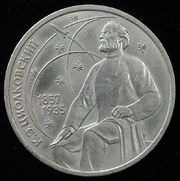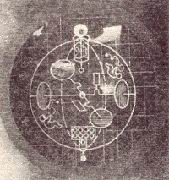Konstantin Tsiolkovsky
| Konstantin Tsiolkovsky | |
|---|---|
 Konstantin Tsiolkovsky
|
|
| Born | September 17 [O.S. September 5] 1857 Izhevskoye |
| Died | September 19, 1935 (aged 78) Kaluga |
| Nationality | Russian/Soviet |
| Fields | astronautic theory |
| Known for | Tsiolkovsky's rocket equation |
Konstantin Eduardovich Tsiolkovsky (Russian: Константи́н Эдуа́рдович Циолко́вский; (September 17 [O.S. September 5] 1857 – September 19, 1935) was an Imperial Russian and Soviet rocket scientist and pioneer of the astronautic theory. He is considered by many to be the father of theoretical astronautics.[1] His works later inspired leading Soviet rocket engineers such as Sergey Korolyov and Valentin Glushko and contributed to the early success of the Soviet space program.
Tsiolkovsky spent most of his life in a log house on the outskirts of Kaluga, about 200 km (125 miles) southwest of Moscow. A misanthrope by nature, he appeared strange and bizarre to his fellow town-folk.
Contents |
Biography
He was born in Izhevskoye (now in Spassky District, Ryazan Oblast), in the Russian Empire, to a middle-class family. His father, Edward Tsiolkovsky (in Polish: Ciołkowski), was Polish; his mother, Maria Yumasheva, was an educated Russian (of partly Tatar origin) woman.[2] His father was a Polish patriot deported to Russia as a result of his revolutionary political activities.[3] At the age of 9, Konstantin caught scarlet fever and became hard of hearing.[4] He was not admitted to elementary schools because of his hearing problem, so he was self-taught.[4]
Inspired by the fiction of Jules Verne, Tsiolkovsky theorized many aspects of space travel and rocket propulsion. He is considered the father of spaceflight and the first man to conceive the space elevator, becoming inspired in 1895 by the newly-constructed Eiffel Tower in Paris.
Tsiolkovsky was also an adherent of philosopher Nikolai Fyodorov, and believed that colonizing space would lead to the perfection of the human race, with immortality and a carefree existence.[5]
Nearly deaf, Tsiolkovsky worked as a high school mathematics teacher until retiring in 1920. Only from the mid 1920s onwards was the importance of his work acknowledged by others, and Tsiolkovsky was honoured for it. He died on 19 September 1935 in Kaluga and was buried in state.[5]
Work

In the late 19th and early 20th century, Tsiolkovsky delved into theories of heavier-than-air flying machines, independently working through many of the same calculations that the Wright brothers were doing at the same time. However, he never built any practical models, and his interest shifted to more ambitious topics.
In 1923, German physicist Hermann Oberth published his thesis By Rocket into Planetary Space, which triggered wide-scale interest and scientific research on the topic of space flight. It also reminded Friedrich Zander about once having read an article on the subject. After contacting the author, he became active in promoting and further developing Tsiolkovsky's work. In 1924 Zander established the first astronautics society in the Soviet Union, the Society for Studies of Interplanetary Travel, and later researched and built liquid-fueled rockets named OR-1 (1930) and OR-2 (1933).
In 1924, a writer for the Russian newspaper Izvestiya reported on A Method of Reaching Extreme Altitudes, a groundbreaking work on the rocketry experiments being done by Robert Goddard, which had been published in 1919 but was not noticed in the Soviet Union until Hermann Oberth referenced it in his later work. When news of the article reached Tsiolkovsky, he decided to republish his early works along with a flurry of new articles about space.[6]

Only late in his lifetime was Tsiolkovsky honoured for his pioneering work. On 23 August 1924 he was elected as a first professor of the Zhukovsky Airforce Academy named after N. E. Zhukovsky (Russian: Военно-воздушная академия им. Н. Е. Жуковского).
His most important work, published in 1903, was The Exploration of Cosmic Space by Means of Reaction Devices (Russian: Исследование мировых пространств реактивными приборами),[7] Tsiolkovsky calculated that the horizontal speed required for a minimal orbit around the Earth is 8,000 m/s (5 miles per second) and that this could be achieved by means of a multistage rocket fueled by liquid oxygen and liquid hydrogen.

During his lifetime he published over 500 works on space travel and related subjects, including science fiction novels. Among his works are designs for rockets with steering thrusters, multi-stage boosters, space stations, airlocks for exiting a spaceship into the vacuum of space, and closed cycle biological systems to provide food and oxygen for space colonies.
Tsiolkovsky had been developing the idea of the air cushion since 1921, publishing fundamental paper on it in 1927, entitled "Air Resistance and the Express Train" (Russian: Сопротивление воздуха и скорый поезд).[8][9] In 1929 Tsiolkovsky proposed the construction of multistage rockets in his book Space Rocket Trains (Russian: Космические ракетные поезда).
Tsiolkovsky's work influenced later rocketeers throughout Europe, like Wernher von Braun, and was also studied by the Americans in the 1950s and 1960s as they sought to understand the Soviet Union's successes in space flight.
Tributes

- The basic equation for rocket propulsion, the Tsiolkovsky rocket equation, is named after him.
- The State Museum of the History of Cosmonautics in Kaluga now bears his name.
- The crater Tsiolkovskiy (the most prominent crater on the far side of the Moon) was named after him, while asteroid 1590 Tsiolkovskaja was named after his wife.[10][11] (The Soviet Union obtained naming rights by operating Luna 3, the first space device to successfully transmit images of the side of the moon not seen from Earth.[12])
In popular culture
- SF writer Alexander Beliaev has written a book in which a city and a space station are named after him.
- A lunar station is named Tsiolkovsky in Stanisław Lem's novel Tales of Pirx the Pilot, story "The Conditional Reflex".
- A space station is named Tsiolkovsky 1 in William Gibson's short story Hinterlands.
- The character Aeolia Schenberg in the anime series Mobile Suit Gundam 00 is based on Tsiolkovsky.
- The Zvezda module of the International Space Station has photos of Tsiolkovsky and Yuri Gagarin posted on the wall above the aft hatchway.[13]
- The Space Elevators in the Horus Heresy novel Mechanicum are called "Tsiolkovsky Towers".
- The Science ship in the Star Trek TNG The_Naked_Now episode is named after him.
See also

- Russian philosophy
- Space exploration
- Spaceflight
- Space colonization
- History of the internal combustion engine
- Timeline of hydrogen technologies
- Tsiolkovsky rocket equation
- Cosmonauts Alley
Works
- (Russian) Tsiolkovsky, Konstantin E. (1903), "The Exploration of Cosmic Space by Means of Reaction Devices (Исследование мировых пространств реактивными приборами)", The Science Review (5), http://www.epizodsspace.ru/bibl/dorev-knigi/ciolkovskiy/issl-03sovr.html
- (Russian) Tsiolkovsky, Konstantin E. (1931) (PDF), Origin and an Essence of Music (Происхождение музыки и ее сущность), http://upload.wikimedia.org/wikipedia/commons/6/6c/Origin_of_music_by_Tsiolkovsky.pdf, retrieved 2008-09-22
Further reading
- Andrews, James T., Red Cosmos: K.E. Tsiolkovskii, Grandfather of Soviet Rocketry, Texas A & M University Press, 2009, ISBN 978-1-60344-168-1[14]
Notes
- ↑ Konstantin E. Tsiolkovsky - Soviet Space Scientist. From San Diego Aerospace Museum Educational Materials
- ↑ Земной путь звездоплавателя. Retrieved from http://www.melnikoff.com/nikita/tsiolkovskiy/earth_way.htm.
- ↑ Solecki, Roman (date unknown). Prominent Poles: Konstanty Ciolkowski (Konstantin Eduardovich Tsiolkovsky) Russian rocket scientist of Polish ancestry, pioneer of cosmonautics, visionary, inventor. University of Connecticut Union, USA. Retrieved from http://www.angelfire.com/scifi2/rsolecki/konstanty_ciolkowski.html.
- ↑ 4.0 4.1 Narins, Brigham (2001), Notable Scientists from 1900 to the Present, 5, Farmington Hills, MI: The Gale Group, pp. 2256–2258, ISBN 078765454X
- ↑ 5.0 5.1 The life of Konstantin Eduardovitch Tsiolkovsky 1857-1935
- ↑ Asif Siddiqi, "Deep Impact: Robert Goddad and the Soviet Space Fad of the 1920s", History and Technology June 2004.
- ↑ (Russian) Tsiolkovsky, Konstantin E. (1903), "The Exploration of Cosmic Space by Means of Reaction Devices (Исследование мировых пространств реактивными приборами)", The Science Review (5), http://epizodsspace.testpilot.ru/bibl/dorev-knigi/ciolkovskiy/issl-03st.html, retrieved 2008-09-22
- ↑ Gillispie, Charles Coulston (1980), Dictionary of Scientific Biography, Charles Scribner's Sons, p. 484, ISBN 0684129256
- ↑ (Russian) Air Cushion Vehicle History, Neptune Hovercraft Shipbuilding Company, http://www.hovercraft.ru/history.html, retrieved 2008-09-22
- ↑ The Life of Konstantin Eduardovitch Tsiolkovsky, Konstantin E. Tsiolkovsky State Museum of the History of Cosmonautics, http://www.informatics.org/museum/tsiol.html, retrieved 2008-09-22
- ↑ Konstantin E. Tsiolkovsky Scientific Biography, Konstantin E. Tsiolkovsky State Museum of the History of Cosmonautics, http://www.informatics.org/museum/tsilbio.html, retrieved 2008-09-22
- ↑ Soviet Missions to the Moon
- ↑ International Space Station Imagery
- ↑ http://www.thespacereview.com/article/1508/1
External links
- Tsiolkovsky's Imperative in the 21st Century Academic paper
- Tsiolkovsky's house The house museum of Tsiolkovsky
- Virtual Matchbox Labels Museum - Russian labels - Space - Page 2 - Konstantin Tsiolkovsky Historic images
- Tsiolkovsky from Russianspaceweb.com
- Spaceflight or Extinction: Konstantin Tsiolkovsky Excerpts from "The Aims of Astronautics", The Call of the Cosmos
- The Foundations of the Space Age
|
|||||||||

.jpg)